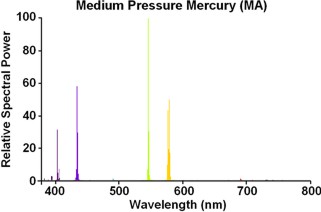
|
Mazda A-H1 Medium Pressure Mercury |

In America it quickly became known as the H1. Several different variants emerged over time, This A-H1 is intended for burning in the vertical cap-up position. Type B-H1 has an inverted arc tube to permit cap-down use. It is important that the tip-off area is always uppermost, otherwise its slightly lower temperature may lead to the condensation of mercury inside the tip, thus preventing the lamp from fully running up. The D-H1 and E-H1 lamps were GE and Westinghouse's respective attempts at quartz lamps, whose more refractory arc tubes could be burned horizontally. The higher mercury vapour pressure also delivered increased luminous efficacy. A later F-H1 lamp was identical to the A-H1 but featured a more rugged mechanically fixed cap.
The discharge operates at a mercury pressure of 1.2 atmospheres, the same as the standard MA 400W. The arc tube is fabricated from a blown aluminosilicate bulb. The main electrodes take the form of open tungsten coils impregnated with barium, strontium and calcium oxides as the emissive material. They are supported on a molybdenum T-piece, and the auxiliary ignition electrode is a simple rod alongside one of the main electrodes. As was standard practice with the American lamps, there is no platinum heat-reflective coating in the area behind the electrodes - hence the sensitivity to burning position, and the need to offer both cap up and cap down variants.



| Manufacturer: | General Electric Co. USA | |
| Lamp Power: | 400 Watts | |
| Lamp Current: | 3.2 Amps | 5A starting current |
| Lamp Voltage: | 137 Volts | 220V starting voltage |
| Cap Type: | E39s/41 | Brass + vitrite |
| Bulb Finish: | Clear | Lead borosilicate glass |
| Bulb Type: | T-51 | T-16 in eighths/inch |
| Overall Length: | 330 mm | 13 inches |
| Light Centre Length: | 197 mm | 7¾ inches |
| Arc Length: | 152 mm | 6 inches |
| Electrodes: | CCC-8 Triple Coil | Ba-Sr-O emitter |
| Atmosphere: | Inner: Hg | Ar (1.2 atm) | Outer: Nitrogen |
| Luminous Flux: | 16,000 lm | (@ 100 hours) |
| Luminous Efficacy: | 40.0 lm/W | (@ 100 hours) |
| Colour Temperature & CRI: | CCT: 5400K | CRI: Ra 6 |
| Chromaticity Co-ordinates: | CCx: 0.337 | CCy: 0.421 |
| Burning Position: | Vertical Base Up ± 10° | |
| Rated Lifetime: | 4000 hours | (to 50% survival) |
| Warm-up & Re-strike Time: | 7 minutes | 7 minutes |
| Factory: | Hoboken, NJ | U.S.A. |
| Date of Manufacture: | April 1945 | Date Code: 64 |
| Original & Present Value: | US $10.50 (1947) | £50.52 (2005) |
